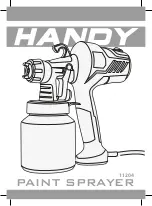
35
34
1 = Material inlet fitting (G 1/4“) marked with
M
2 = Atomizing air inlet fitting (G 1/8“) marked with
Z
3 = Control air inlet fitting (G 1/8“) marked with
ST
4 = Material inlet fitting for the circulation versions of the PILOT WA 7XX models
The spray gun is now properly installed and connected and ready for operation.
5
Operational Handling
5.1
Safety Warnings
Please pay special attention to the following safety warnings prior to taking this spray
gun into operation!
•
Wear proper respiratory protection masks and protective overalls, whenever you
are operating this spray gun. Air-borne particles represent a health hazard.
•
Make sure to wear suitable haering protectors. The gun produces sound levels
of up to 86 dB (A) which may cause hearing defects.
•
Open fires, naked lights and smoking prohibited in the working area. Spraying
of readily flammable media such as paints and adhesive compounds is always
accompanied by the risk of fire and explosion.
5.2
Starting / Stopping Requirements
The following requirements must be met before taking this spray gun into operation:
•
control air must be available at the gun.
•
atomizing air must be available at the gun.
•
material pressure must be available at the gun.
Caution
The material pressure shall not exceed
• 8 bar
, as, otherwise, the functional
reliability of the spray gun will suffer.
Adjust the control air pressure to
• at least 4,5 bar
, in order to operate the spray gun.
The operation of the spray gun can be started/stopped by way of the 3/2-way control
valve (see the Operating Instructions of the plant systems manufacturer).
Warning
It is important to remember that the spray gun must be relieved of all pressures
whenever work is terminated. Lines left in pressurized condition could burst, with
their contents likely to injure anybody present nearby.
5.3
Spray Pattern Test
Spray pattern tests should be performed whenever:
•
the spray gun is taken into operation for the first time.
•
the spraying medium is changed.
•
the spray gun was taken apart for servicing or repairs.
The spray pattern can be tested using a work piece sample, a sheet of metal,
cardboard or paper.
Warning
Keep away from the front of the spray gun - imminent risk of injury.
Warning
Make sure that nobody is present in the spraying zone when the gun is started
- imminent Risk of Injury.
1. Start the gun to produce a spray pattern sample (see
5.2. Starting/Stopping
Requirements
).
2. Inspect the sample and readjust the settings of the gun as may be required (see
5.4 Spray Pattern Adjustments
).
5.4
Spray Pattern Adjustments
The spray pattern of the of the series PILOT WA 7XX models can be adjusted as
follows:
Adjusting the jet pattern
Adjustment of the material flow rate
Adjustment of the Material Pressure
This adjustment can only be made at the pump or the material pressure tank. Please
comply with the operating instructions and safety warnings issued by the
manufacturers concerned.
An optimum spray pattern can be regulated by
using adjustment screws
B
and
R
.
The adjustment screw
B
regulates the wide/ flat jet,
the adjustment screw
R
regulates the round jet.
Turn cap (1) from the standard position
•
to the inside in order to decrease the material
flow rate.
•
to the outside in order to increase the material
flow rate.
The material flow through the nozzle can be perfor-
med without using atomizing air, when the drawbar
(2).
R
B
2
1
















































